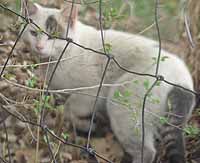| Feral cats run wild in many places in Carbon County. The animal shelter in combination with an animal hospital in the area have set up a program where people who are feeding the hard to catch animals can work out a program to trap them and have them neutered for a minimal cost. |
Cats possess an air of independence that tends to make people think the felines can survive in natural or non-domesticated setting.
Therefore, many individuals who end up with unwanted cats or kittens dump the felines off to get rid of the animals.
The problem of feral cats has existed for generations. But during the last few years, the matter has come to the attention of the general public because the problem has reached an almost epidemic level.
Wild cats are, in most cases, the result of ignorance on the part of people who fail to have the animals spayed or neutered.
The failure to spay or neuter cats virtually guarantees a number of offspring.
People may fear that taking the kittens to an animal shelter may lead to the felines being put to death.
Or perhaps people may be embarrassed because they did not have the parent cat fixed.
But the result is frequently the same – people send the unwanted cats out the door, either down the street or across town.
“It’s a real problem in our area,” emphasizes Patti Pierce, manager of the Carbon County Animal Shelter. “Many people just don’t take care of their animals and then, suddenly, they have kittens and want to get rid of them.”
The problem is severe in many parts of the country, causing dissention and anger among many people who love animals.
In December 1996, animal rights groups were enraged when the East Bay district board hired a contractor from the federal animal damage control agency to shoot and kill feral cats that were part of a human-fed colony in Garin Regional Park near Hayward, Calif.
Members of Community Concern for Cats and feline lovers, who had been feeding the feral animals as part of a trap-neuter-release program, raised an outcry of rage at the killings.
Often, people decide to take things into their own hands and, sometimes, act to satisfy other needs.
Last year, Carbon animal control personnel discovered numerous crude cat traps in the area that an unidentified resident had built.
Apparently, the individual had been trapping cats and using the animals for hunting practice.
But constructing the devices and following similar techniques to trap cats are unlawful practices.
The problem of feral cats is difficult to resolve, particularly as long as people do not care about what happens.
During the recent winter season, the Carbon Animal Shelter housed as many as 50 cats at one time. As of Monday, the facility had 31 cats. However, the situation will probably change in the near future.

